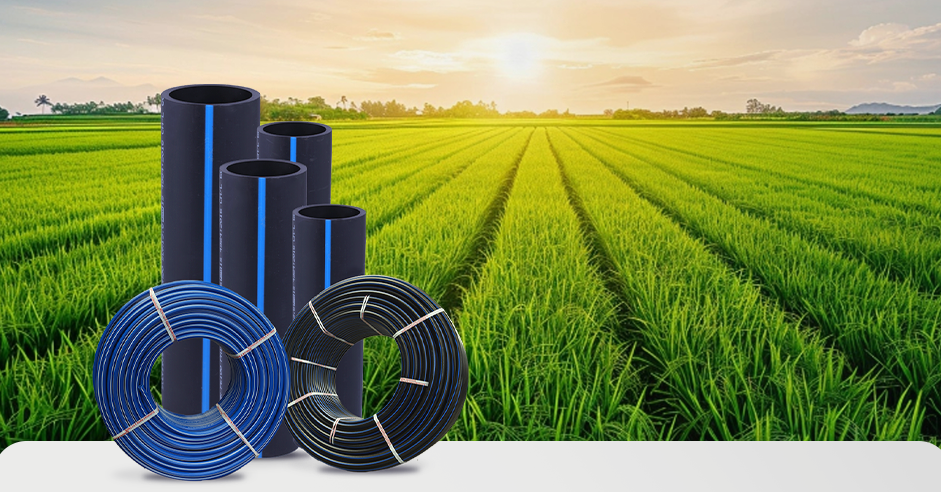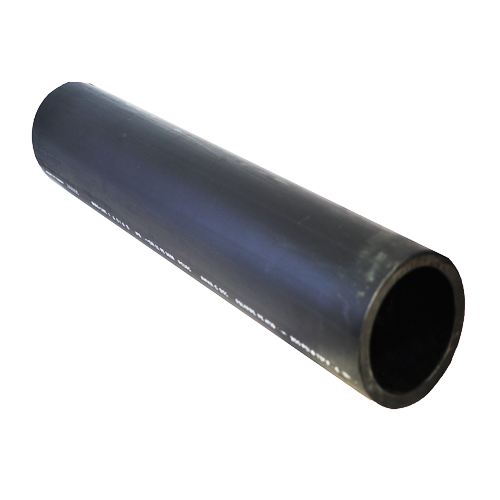Why Partnering with Pipe Supplier American Plastics Midland Ensures Timely Supply
Explore the Production Refine Behind High-Quality HDPE Pipe and Its Applications
The manufacturing process of premium HDPE pipes is elaborate and methodical. It begins with the selection of resources that boost efficiency. Following this, ethylene undergoes polymerization to form resin, which is then formed with extrusion. Quality control is paramount, ensuring that the final product meets rigid criteria. Nonetheless, the trip of HDPE pipes doesn't finish with production. Their applications throughout various industries disclose a wider significance worth examining.
Recognizing HDPE: Residences and Advantages

High-density polyethylene (HDPE) is a flexible thermoplastic known for its resilience and resistance to various environmental elements. This material shows outstanding tensile toughness, making it appropriate for requiring applications. Its low-density structure adds to a light-weight item, promoting ease of dealing with and installment. HDPE likewise showcases remarkable resistance to chemicals, which decreases deterioration when revealed to harsh substances.
The product's reduced moisture absorption additionally boosts its durability, making it perfect for usage in pipes and tank. In addition, HDPE is immune to ultraviolet (UV) radiation, making sure that items maintain their stability even when revealed to sunshine. Its adaptability allows for the development of complex shapes without jeopardizing toughness. The environment-friendly nature of HDPE, commonly stemmed from recycled products, contributes to its allure, promoting sustainable techniques in manufacturing. On the whole, these homes and benefits make HDPE a preferred option for different commercial and consumer applications.
Raw Product Option for HDPE Manufacturing
The choice of basic materials for HDPE manufacturing is important to confirm the end product satisfies the wanted requirements and top quality requirements. High-density polyethylene (HDPE) is largely produced from polymerized ethylene, originated from fossil gas such as natural gas or crude oil. The high quality of these feedstocks greatly affects the mechanical and thermal homes of the final HDPE.
Additives additionally play a significant duty in enhancing HDPE's efficiency, including antioxidants, UV stabilizers, and colorants, which enhance toughness and resistance to ecological aspects. The selection procedure need to think about not just the chemical make-up of the raw materials but additionally their handling features to guarantee efficient production.
Moreover, the sourcing of resources must focus on sustainability and compliance with ecological guidelines, as responsible techniques are crucial in today's market. Ultimately, cautious raw material choice lays the structure for producing high-quality HDPE pipelines suitable for diverse applications.
The Extrusion Process: Forming HDPE Pipe
The extrusion process plays an important duty in forming HDPE pipelines, starting with precise material prep work methods that guarantee excellent flow and consistency. Similarly vital is the style of the die, which directly influences the final measurements and surface area quality of the pipeline. With each other, these factors add greatly to the performance and quality of HDPE pipeline manufacturing.
Product Preparation Strategies
Effective production of HDPE pipelines begins with careful material prep work techniques, particularly the extrusion process. Throughout this stage, high-density polyethylene resin is first dried to get rid of wetness, ensuring excellent circulation attributes. The material is after that fed into the extruder, where it undergoes heating and melting, changing into a viscous state. This home heating process is very carefully managed to preserve the material's integrity and performance. The molten HDPE is forced via a die, forming it right into a continuous pipe form. Proper temperature monitoring throughout extrusion is necessary, as it directly affects the product's residential or commercial properties and the end product top quality. As soon as shaped, the HDPE pipe is cooled and reduced to specified lengths, all set for succeeding processing and applications.
Die Design Significance
Accuracy in die layout plays an essential duty in the extrusion procedure of HDPE pipelines. The die acts as the last shaping tool, directly affecting the pipe's dimensions, wall surface density, and surface coating. A properly designed die warranties uniform product flow, reducing issues such as abnormalities and weak points. The geometry of the die have to be enhanced to accommodate the details homes of HDPE, including its viscosity and thermal actions throughout extrusion. Furthermore, the cooling price of the material as it travels through the die can considerably impact the pipe's architectural integrity. Subsequently, investing in innovative die technology is crucial for producers intending to create top quality HDPE pipelines that satisfy sector requirements and consumer assumptions.
Top Quality Control Actions in HDPE Production
Although various elements affect the top quality of HDPE pipeline production, effective quality assurance procedures are essential to assure uniformity and integrity in the last item. Key top quality control techniques consist of strenuous material evaluation, confirming that the raw polyethylene meets well established criteria for pureness and density. Throughout the extrusion procedure, parameters such as temperature level, stress, and cooling time are carefully monitored to keep dimensional accuracy and structural integrity
Furthermore, post-production testing is necessary; makers commonly carry out hydrostatic examinations to analyze the pipe's strength and resistance to stress. Aesthetic examinations for surface area problems better improve top quality guarantee. Accreditation from appropriate standards companies, like ASTM or ISO, gives an added layer of integrity. By executing these comprehensive quality control procedures, manufacturers can lessen problems, boost performance, and make sure that the HDPE pipes meet the details requirements of different applications, inevitably causing client satisfaction and depend on in the item.
Applications of HDPE Pipe Across Industries
HDPE pipes are used throughout various sectors as a result of their sturdiness and versatility. In check here water distribution systems, they assure effective distribution, while in wastewater management, they offer trustworthy options for waste transport. Furthermore, agricultural watering networks gain from HDPE's resistance to rust and versatility, making it an ideal option for modern-day farming practices.

Water Circulation Systems
A considerable variety of industries rely upon high-density polyethylene (HDPE) pipes for effective water circulation systems. Known for their longevity and resistance to deterioration, HDPE pipes are widely utilized in community supply of water networks, farming irrigation, and commercial applications. Their lightweight nature assists in very easy handling and setup, decreasing labor prices and time. In addition, HDPE pipes can accommodate different pressure degrees, making them suitable for both low and high-pressure systems. custom hdpe pipe manufacturing Midland TX. The adaptability of the product permits seamless combination right into existing infrastructure, reducing the need for comprehensive excavation. HDPE's resistance to chemical leaching guarantees that the water supplied remains risk-free and tidy, making it an ideal choice for preserving the top quality of potable water across different markets.
Wastewater Management Solutions
Reliable water circulation systems also pave the method for cutting-edge wastewater monitoring services, where high-density polyethylene (HDPE) pipes play a substantial role. Popular for their durability and resistance to corrosion, HDPE pipelines are optimal for moving wastewater in various settings. Their flexibility permits simple setup in complicated atmospheres, lessening the requirement for extensive excavation. Additionally, HDPE's smooth interior surface decreases friction, boosting circulation rates and performance. These pipelines are likewise immune to chemical leaching, making certain that impurities do not endanger the surrounding setting. Industries, municipalities, and treatment centers significantly depend on HDPE pipelines for their integrity and longevity, making them a recommended selection for contemporary wastewater administration systems. This adaptability emphasizes the critical relevance of HDPE pipes throughout many applications.
Agricultural Watering Networks
Agricultural watering networks profit significantly from making use of high-density polyethylene (HDPE) pipes, which supply efficient and trusted water shipment to crops. HDPE pipelines are lightweight, making them very easy to move and mount, while their versatility enables numerous setups in varied surfaces. These pipelines demonstrate excellent resistance to deterioration, chemicals, and UV radiation, making certain toughness in severe farming atmospheres. Additionally, their smooth indoor surface decreases friction loss, maximizing water flow and lowering energy costs related to pumping. The long life of HDPE pipes, often going beyond half a century, contributes to decrease maintenance and substitute expenditures. Farmers significantly depend on HDPE pipelines to boost irrigation efficiency and promote sustainable farming methods, inevitably leading to improved plant returns and source preservation.

Future Trends in HDPE Pipe Modern Technology
As the need for sustainable and reliable infrastructure expands, innovations in HDPE pipe technology are positioned to change various industries. Emerging fads consist of the combination of clever modern technologies, such as sensing units and IoT capabilities, which help with real-time surveillance of pipeline conditions, lowering upkeep expenses and protecting against leaks. In addition, the growth of advanced manufacturing methods, such as 3D printing, is making it possible for the manufacturing of complex, tailored pipe styles that cater to specific job requirements.
Moreover, the concentrate on recycling and circular economic climate methods is driving the technology of HDPE pipelines made from recycled materials, enhancing sustainability. Boosted jointing approaches, such as electro-fusion and mechanical fittings, are additionally enhancing setup effectiveness and dependability. The expanding focus on ecological policies is pressing suppliers to adopt greener production procedures, making certain that HDPE pipes not just satisfy sector criteria however also cultivate an even more lasting future for infrastructure growth.
Often Asked Questions
How Does HDPE Compare to Various Other Plastic Materials?
HDPE surpasses several other plastic materials regarding durability, chemical resistance, and versatility. Its low density and high tensile strength make it ideal for different applications, commonly surpassing options in both efficiency and longevity.
What Are the Ecological Influences of HDPE Production?
The ecological effects of HDPE manufacturing consist of greenhouse gas exhausts, power consumption, and prospective air pollution from manufacturing procedures. Furthermore, improper disposal can result in dirt and water contamination, raising issues regarding long-term ecological impacts.
Can HDPE Piping Be Recycled?
Yes, HDPE pipes can be recycled. Lots of centers approve used HDPE for processing, changing it into new products. This recycling adds to sustainability initiatives, lowering plastic waste while preserving sources and energy in the manufacturing cycle.
What Is the Life Expectancy of HDPE Piping?

Exactly How Do Temperature Variations Impact HDPE Pipe Efficiency?
Temperature level variations considerably influence HDPE pipe performance, impacting adaptability and toughness. High temperature levels can cause softening, while reduced temperature levels might cause brittleness, ultimately influencing the pipeline's toughness and viability for numerous applications in varied environments.